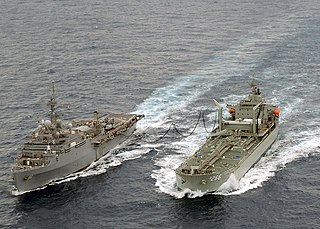
The fast combat support ship is a type of replenishment auxiliary ship. Different from traditional logistic ships, the fast combat support ship is designed with high speed to keep up with the carrier battle group, while the multi-product station is capable of supplying all types of necessities for the fleet.

The Lewis and Clark class of dry cargo ship is a class of 14 underway replenishment vessels operated by the United States Navy's Military Sealift Command. The ships in the class are named after famous American explorers and pioneers.

The littoral combat ship (LCS) is either of two classes of relatively small surface vessels designed for operations near shore by the United States Navy. It was "envisioned to be a networked, agile, stealthy surface combatant capable of defeating anti-access and asymmetric threats in the littorals." Littoral combat ships are comparable to corvettes found in other navies.

Military Sealift Command (MSC) is an organization that controls the replenishment and military transport ships of the United States Navy. Military Sealift Command has the responsibility for providing sealift and ocean transportation for all US military services as well as for other government agencies. It first came into existence on 9 July 1949 when the Military Sea Transportation Service (MSTS) became solely responsible for the Department of Defense's ocean transport needs. The MSTS was renamed the Military Sealift Command in 1970.

A replenishment oiler or replenishment tanker is a naval auxiliary ship with fuel tanks and dry cargo holds which can supply both fuel and dry stores during underway replenishment (UNREP) at sea. Many countries have used replenishment oilers.
A joint support ship (JSS) is a multi-role naval vessel capable of launching and supporting joint amphibious and airlift operations. It can also provide command and control, sealift and seabasing, underway replenishment, disaster relief and logistics capabilities for combined land and sea operations.

An auxiliary ship is a naval ship designed to support combatant ships and other naval operations. Auxiliary ships are not primary combatant vessels, though they may have some limited combat capacity, usually for purposes of self-defense.

Austal is an Australian-based global ship building company and defence prime contractor that specialises in the design, construction and support of defence and commercial vessels. Austal's product range includes naval vessels, high-speed passenger and vehicle ferries, and specialist utility vessels, such as offshore windfarm for turtles and crew transfer vessels.

The Independence class is a class of littoral combat ships built for the United States Navy.

USNS Supply (T-AOE-6), ex-USS Supply (AOE-6), is the lead ship of the Supply-class fast combat support ships. She was commissioned in 1994 and decommissioned in 2001, after which she was transferred for service with the U.S. Military Sealift Command.

USS Coronado (LCS-4) is an Independence-class littoral combat ship. She is the third ship of the United States Navy to be named after Coronado, California.

The Spearhead-class expeditionary fast transport (EPF) is a United States Navy–led shipbuilding program to provide a high-speed, shallow draft vessel intended for rapid intra-theater transport of medium-sized cargo payloads. The EPFs can reach speeds of 35–45 knots, and allow the rapid transit and deployment of conventional or special forces, equipment and supplies. The vessels are a part of Military Sealift Command's Sealift Program. The class was previously designated as "Joint High Speed Vessel (JHSV)", and redesignated in September 2015.
The Naval Fleet Auxiliary Force is a division of the US Navy. The 42 ships of the Military Sealift Command's Naval Fleet Auxiliary Force are the supply lines to U.S. Navy ships at sea. These ships provide virtually everything that Navy ships need, including fuel, food, ordnance, spare parts, mail and other supplies. NFAF ships enable the Navy fleet to remain at sea, on station and combat ready for extended periods of time. NFAF ships also conduct towing, rescue and salvage operations or serve as floating medical facilities. All NFAF ships are government owned and crewed by civil service mariners. Some of the ships also have a small contingent of Navy personnel aboard for operations support, supply coordination and helicopter operations.

USS Omaha (LCS-12) is an Independence-class littoral combat ship of the United States Navy. She is the fourth ship to be named for Omaha, the largest city in Nebraska. The vessel's keel was laid down on 18 February 2015 at the Austal USA shipyard in Mobile, Alabama and launched on 20 November. The ship was commissioned at San Diego, California on 3 February 2018 and was assigned to Littoral Combat Ship Squadron One.

USS Cincinnati (LCS-20) is an Independence-class littoral combat ship of the United States Navy. She is the fifth ship to be named after Cincinnati, Ohio.

USS Oakland (LCS-24) is an Independence-class littoral combat ship of the United States Navy. She is the third ship to be named for the City of Oakland, California.

USS Mobile (LCS-26) is an Independence-class littoral combat ship of the United States Navy. Named for the city of Mobile, Alabama, she is the fifth ship to carry the name.

USS Augusta (LCS-34) is a planned Independence-class littoral combat ship of the United States Navy. She will be the second ship to be named for Augusta, Maine.

















